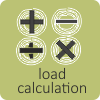HVAC load calculation and reduction is a complex process involving many factors which directly or indirectly effect the load requirement. Over years, professionals have come up with average thumb rules to save time on tedious process of complex load calculations. Since load requirement effect the capital and operational cost, thermal comfort, ventilation rate & indoor air quality, and energy efficiency, it is important to estimate the load requirement specific to the building. Key steps required for estimating the load requirement are as below:
- Avoid rules of thumb: Over the last decade, many energy efficient equipment and passive design strategies have come into the market which have imparted energy efficiency in the built environment and supported the load reduction but the rules of thumb have not changed till date. This leads to oversized HVAC design and under performance.
Table: Energy Saving Potential in HVAC System Design
Component Cooling Load (kW/ton) Improvement Potential Conventioanal Design Optimized Design Chiller 0.75 0.50 33% Air Distribution Ststem 0.60 0.06 90% Water Pump 0.30 0.04 87% Cooling Tower 0.10 0.02 80% Total 1.75 0.62 65% - Optimize the envelope and lighting specification: Three key factors for load reductions are as below
- Design factor: Key factors to consider under design conditions are building location, air conditioned area, climatic zones, indoor design conditions, orientation, building height, and floor to ceiling height.
- Building envelope factors: Key factors under building envelope are thermal mass, thermal conductivity of envelope, solar heat gain coefficient, shading, and airtightness.
- Internal load factors: Key factors under internal loads are appliance efficiency and equipment schedules, occupancy schedule, ductwork, lighting power density, day light integrations, and controls.
- Use the accurate information for load calculation: It is important to use the accurate specification for each input parameter from vendors, research, or field test. This allows proper sizing and optimized energy efficiency.
- Use relevant tools, standards, and simulation software: The system selection, size optimization, and EE strategies are decided and implemented by discussion with professionals only. Moreover, many tools, simulation software, and standards are available in the market which helps to estimate the load requirement and size accordingly. Few of the best options are available are mentioned below:
- Tools for load calculation –
- Hourly Analysis Program (HAP) – HAP is a power tool for design, sizing, and analysis of HVAC system. It is widely used by comfort system design professionals, engineers, HVAC contractors etc. who are involved in planning, design, and implementation stages of a commercial building comfort system. Key features of HAP are as below:
- Applicable to all types and sizes of commercial buildings
- Covers all complex comfort system types and components
- Applicable for all types of controls integration
- Applicable for new design, retrofit, or energy conservation work
- TRACE 700 – TRACE 700 is another advance tool to support the load calculation, optimize design, and economic analysis of a comfort system. It is widely used by comfort system design professionals, engineers, HVAC contractors etc. who are involved in planning, design, and implementation stages of a commercial building comfort system. Key features of TRACE 700 are as below:
- Advance modelling functionality – TRACE 700 could analyse over 50 air side comfort system, all types of economizers, all sizes of chilled water system & components, VRF, and optimized controls.
- Ease to use – The interface is user friendly and all relevant libraries, weather files etc. are integrated in the software.
- Support and training – Answers to queries are well addressed by the dedicated professionals and global forums.
- Simulation software
- IES VE – IES VE is an advanced software for comfort system design, energy modelling, and performance analysis for comprehensive calculation and accurate results. The software supports the multiple iteration to analyse the impact of additional features on a comfort system for new building or retrofit project. Capable of handling all size of building, IES VE has four tiers –
- VE – Ware – It’s a free energy and carbon foot print analysis tool
- VE – toolkits – It’s a user friendly tool kit for concept and schematic design
- VE – Gaia – It’s an tool that includes concept design analysis, quality check, detail analysis of energy performance and comfort system design, sizing and energy efficiency, and detailed report generation.
- VE – Pro – It’s a powerful, user friendly, and comprehensive building performance tool applicable for energy analysis, day light integration, solar integration, life cycle etc.
- Energy plus – EnergyPlus is a comfort system design, energy analysis, and simulation software which is known for its comprehensive calculations for accurate results. The software results in an integrated solution where all building responses, primary systems, and secondary systems are simultaneously considered for an optimized result. It includes advanced fenestration, heat balance, and day light controls options as well.
- eQuest – eQuest is an advanced, comprehensive, user friendly software for building energy performance analysis, comfort system design, detailed simulation results. The software supports the batch integration effectively to analyse different energy conservation measures on the building and report the comparative analysis on each. It includes advanced fenestration, heat balance, and day light controls options as well.
- IES VE – IES VE is an advanced software for comfort system design, energy modelling, and performance analysis for comprehensive calculation and accurate results. The software supports the multiple iteration to analyse the impact of additional features on a comfort system for new building or retrofit project. Capable of handling all size of building, IES VE has four tiers –
- Hourly Analysis Program (HAP) – HAP is a power tool for design, sizing, and analysis of HVAC system. It is widely used by comfort system design professionals, engineers, HVAC contractors etc. who are involved in planning, design, and implementation stages of a commercial building comfort system. Key features of HAP are as below:
- Standards
- National Building Code (NBC) of India – NBC is a building code which provides comprehensive guidelines to regulate the building construction industry in India. It includes guidelines on each component of building design and construction. The Code mainly contains administrative regulations, development control rules and general building requirements; fire safety requirements; stipulations regarding materials, structural design and construction (including safety); and building and plumbing services.
- Energy Conservation Building Code (ECBC) – ECBC was launched in May 2007 by Ministry of Power, Government of India. The code is meant for all design professionals involved in building design, and construction. The key intent of the code is to promote energy efficiency in building sector and focus on mandatory adoption of code across India. ECBC lists the minimum energy performance for building envelope, lighting systems, HVAC systems, Service water and pumping systems, and electrical systems.
- ASHRAE 90.1, ASHRAE 62, ASHRAE 55 – American Society of Heating, Refrigerating, and Air-Conditioning Engineers (ASHRAE) is an American organization that provides design standards for energy efficiency (ASHRAE 90.1), ventilation and indoor air quality (ASHRAE 62), and thermal comfort (ASHRAE 55). These standards are widely used in India for comfort system design and sizing.
- Tools for load calculation –



















